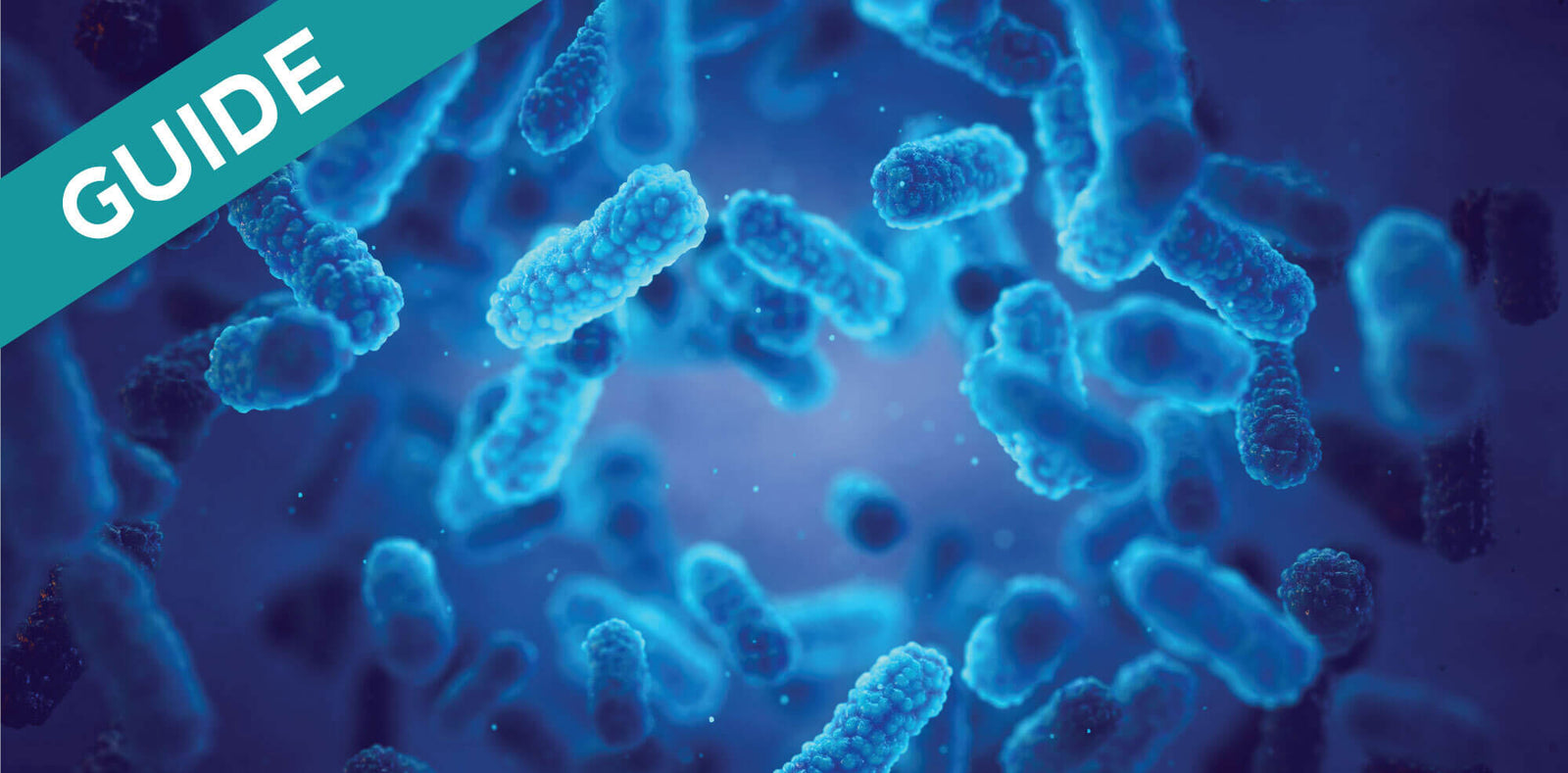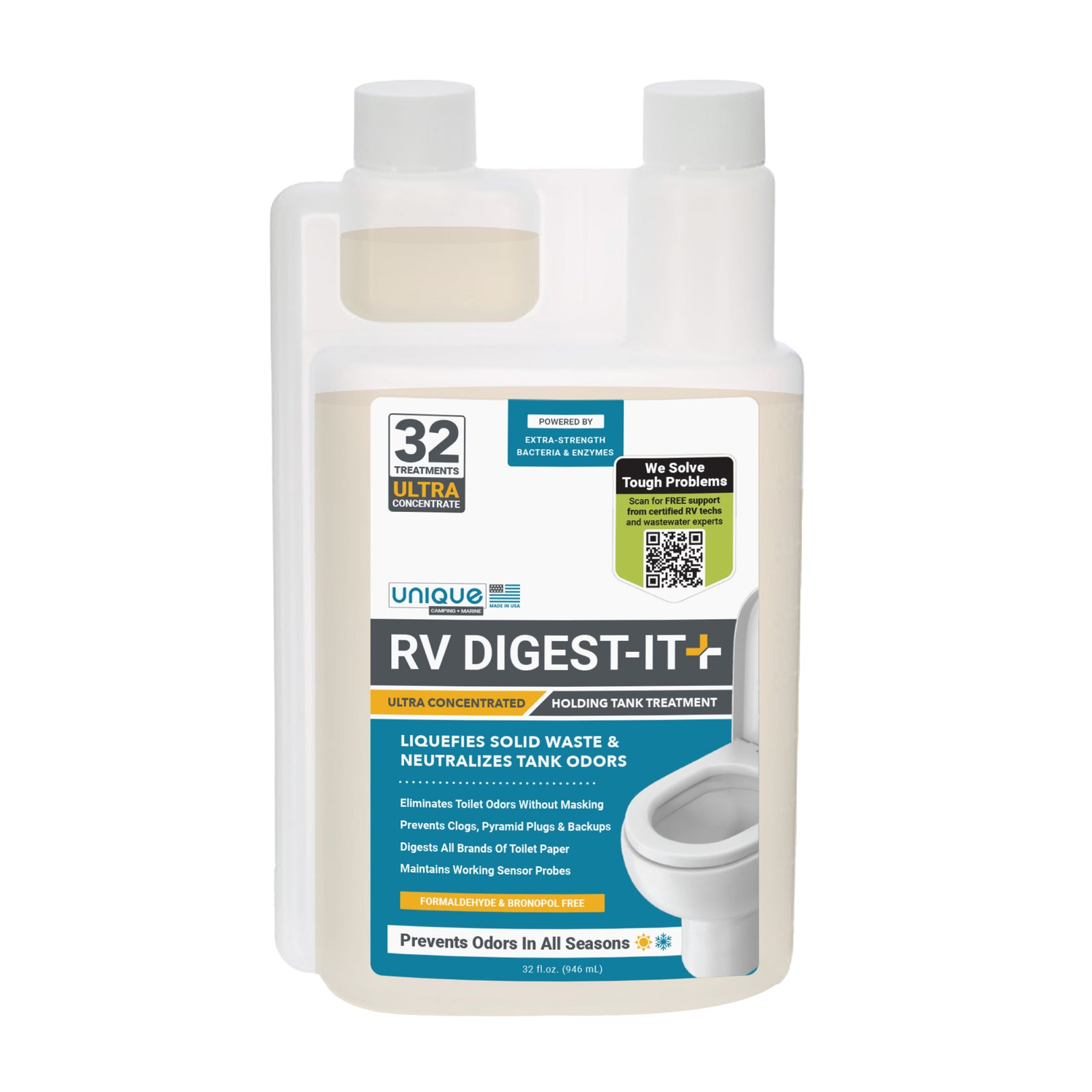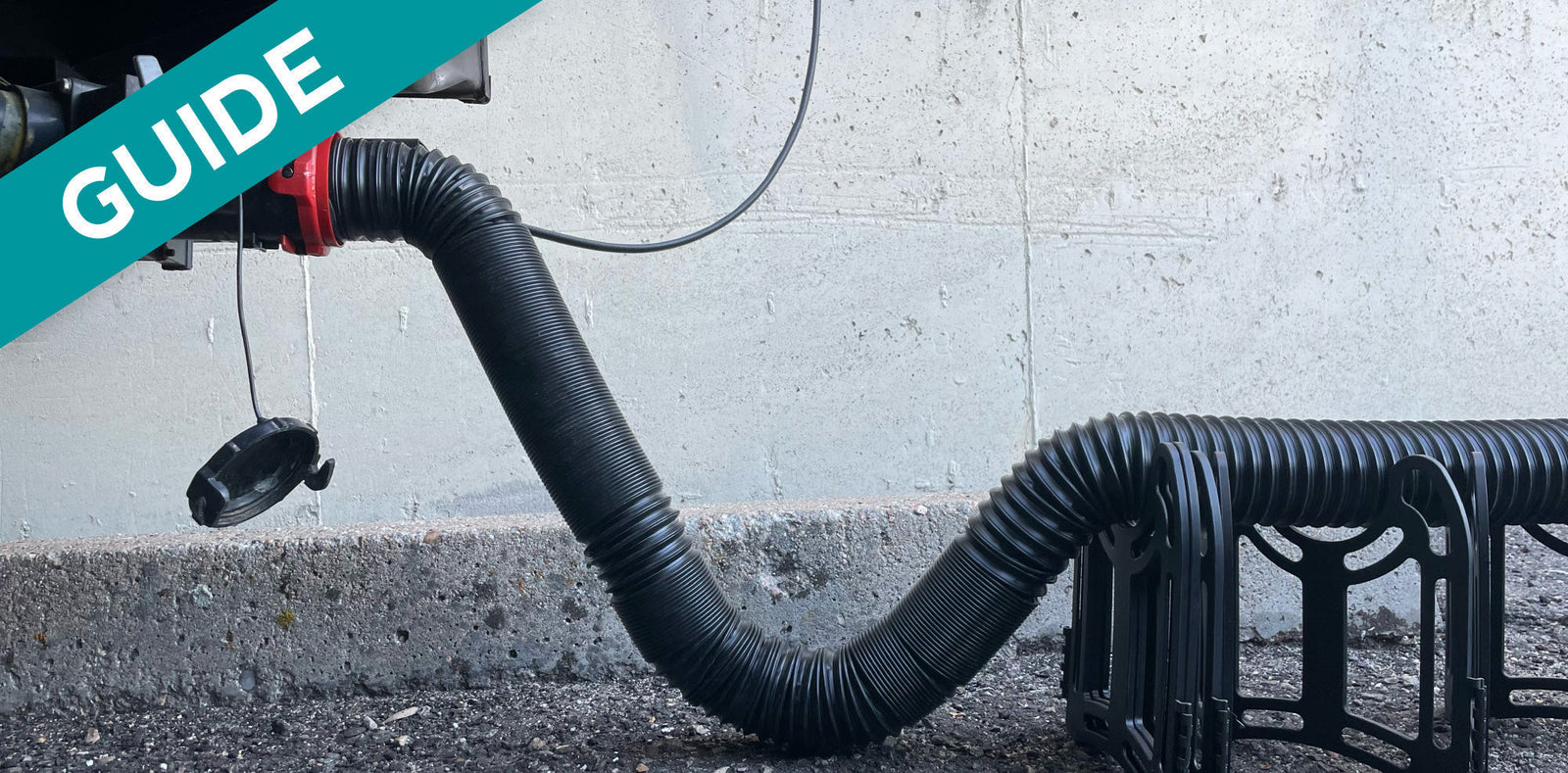
Key Points:
- Bacteria and enzymes are vital to waste breakdown and controlling wastewater tank odors
- You want to encourage the health of the desirable kind of bacteria in your tanks
- Killing bacteria in your tanks will not eliminate foul odors
- Choose effective tank treatment products.
Did you know that you have anywhere from two to six pounds of bacteria on or inside your body at any moment in time? Makes you wonder about all the other surfaces you touch, doesn’t it? Some bacteria can cause problems, but others are essential to make life run smoothly. In fact, bacteria are so essential to life that their absence would lead to a world full of piled up waste; bacteria are the scavengers of the microscopic world and without them, nothing would decay and disappear.
What are bacteria and enzymes?
Most of us have a pretty good idea of what bacteria are because we all remember mom constantly saying, “wash your hands,” “don’t touch that, it has germs.” They are the microscopic organisms that cover almost every surface, exist inside every living thing, and can provide either disease and sickness or benefits like a healthy digestive system and processing of delicious foods. Sometimes bacteria gets a bad reputation because so many people jump to the conclusion that any bacteria is bad bacteria, but consider how many processed food and dairy products require the use of bacteria to ferment or inspire the flavors and textures we know and love:
- Butter
- Cheese
- Yogurt
- Sauerkraut
- Sourdough bread
- Dill pickles
- Olives
- Coffee
- Chocolate
- Meat products
- Beer
Certain types of bacteria are actually beneficial in our bodies because they aid in digestion. This is why many yogurts advertise their product as a good source of probiotic bacteria strains. But a healthy digestive system takes teamwork between bacteria and proteins called enzymes, which come from many different bodily organs, saliva, and even bacteria itself. Enzymes help break down food into smaller chunks so that our digestive system can extract the nutrients and expel the waste. Our bodies naturally produce enzymes and so do the probiotic bacteria found in our gut. Bacteria and enzymes are both crucial for effective digestion and waste breakdown.
Bacteria and enzymes work in a very similar way inside RV wastewater holding tanks. Bacteria from your gut will be deposited into the holding tank(s) every time you use the toilet and it will continue breaking down waste while sitting in the tank(s). Bacteria of any kind create their own enzymes to help them break organic matter into smaller pieces, which makes it easier for them to feed. Yes, the bacteria actually eat the waste; it’s their food source. The enzymes act like the knife to cut up the meal into bite-size pieces. It would take bacteria much longer to digest waste if the enzymes were not there to make the bites smaller. Bacteria is a good thing in your holding tanks, but only the right type. We’ll dive into which types are the stinky kind you want to evict and which ones are the desirable types you want to welcome in.
Which kind of bacteria do I want in my holding tanks?
We will discuss two kinds of bacteria that could be in your holding tanks which perform the same function just in different ways; both will effectively break down waste, but one does it in a stinky way and one doesn’t.
- Aerobic bacteria (odor-free bacteria) thrive in oxygen-rich environments, emitting only carbon dioxide and water as they break down human waste and toilet paper.
- Anaerobic bacteria (odor-causing bacteria) don’t need oxygen to thrive and they release smelly hydrogen sulfide gas as they break down waste.

Anaerobic bacteria are found in your digestive system, and when you use the bathroom in your RV, those anaerobic bacteria get released into your holding tank(s) along with the waste; this is what causes holding tank odors you may have experienced. Aerobic bacteria are found in nature, normally in soil, which is why burying something in the ground will start breaking down quickly. Aerobic bacteria make it into your tank(s) when you add them by way of bacteria-based tank products. The aerobic bacteria found in Unique products are not grown in labs but are collected from nature and then replicated for manufacturing. One of the reasons our bacteria-based products are the strongest and most effective on the market are because we have complete control over our manufacturing of these products and we vary the bacteria strains we use. Different bacteria strains produce specific types of enzymes better equipped for breaking down different organic matter. Having this variety of bacteria strains and, therefore, enzyme types, will increase the breakdown power of the treatment.
Anaerobic bacteria (from the gut) and aerobic bacteria (from nature) will both eat solid waste, which is a crucial step in avoiding clogs and backups, but only aerobic bacteria can consume waste without creating sewage odors. If you add enough aerobic bacteria to your holding tank(s), it will push out the anaerobic bacteria (the kind in your gut), and any toilet smells will be squashed before they begin. Anaerobic bacteria are independent and can eat waste all day without oxygen or water, but aerobic bacteria must have both to survive and thrive. Water is the most important thing to help aerobic bacteria digest waste at peak performance levels. Not only does it hydrate aerobic bacteria (crucial to their survival), but it also allows them to get to the waste. Anaerobic bacteria do not need water as a path to reach waste because it is already present and working from when the poop was in your digestive system, but aerobic bacteria need a ride to the waste, which is where water comes in. Any poop above the waterline will be a haven for anaerobic bacteria.
Aerobic bacteria also lose their effectiveness when temperatures rise above 85 degrees Fahrenheit; the hotter the tank, the less effectively the bacteria will work. But how can you know when your tanks are too hot? We knew this question would come up, so we conducted some brief testing of holding tank temperatures and found that when parked on concrete or asphalt, tank temperatures nearly match the outside ambient temperature but were 10 degrees cooler when parked on grass or dirt. This means simply attaching a thermometer on the outside of your RV will give you a pretty solid reference for what your tank temperatures might be. Also realize that traveling on asphalt roads at high speeds can raise the tank temperature because the heat from the vehicle or RV engine will pass under the RV, right where the tanks reside. Adding water is the best way to cool down the tank, replenish water that has evaporated, and keep aerobic bacteria hydrated and mobile. A bonus feature of completely covering waste with water is that sewage odors released by the anaerobic bacteria are trapped underneath the waterline.
We know...aerobic bacteria are so needy. Sometimes it’s hard to use enough water, dump often, and keep tanks cool. The upside is that all the things aerobic bacteria require actually help your wastewater tanks. Using more water helps to keep seals soft and functional, sensors clear of debris so they can read levels properly, and keep tanks cooler to curb odors. It’s very similar to why we wash our cars; sure we want them to look nice, but it also serves an important purpose to remove dirt, grease and salt debris off rubber seals, tires, and the underbelly of the car so functionality doesn’t degrade. Your holding tanks need similar care to avoid costly repairs. Plus, adding water to tanks for the sake of aerobic bacteria will not damage or harm waste breakdown at dump sites or in your own septic system when it comes time to dump.
So, anaerobic bacteria (the smelly one) and aerobic bacteria (the odorless one) both will digest waste, but unless you like toilet odors, aerobic bacteria are the only ones you want making a home in your black water tank(s).
Why can’t I just kill the bacteria in my holding tanks?
What is the purpose of RV wastewater holding tanks? They are just repositories for wastewater to chill until you get a chance to dump the tanks; they shouldn’t be treated as septic systems because septic systems hold more waste and usually have weeks or months to break down and digest solids, fats, oils, and grease. RV holding tanks usually only hold waste for maybe a week. So you might wonder why bacteria is a benefit in RV wastewater tanks if there’s not much time for the bacteria to work.
As we learned in the previous section, anaerobic bacteria come from your gut and release stinky gases when they digest waste. Obviously, you don’t want this kind of bacteria in your holding tank(s), but it will be put in there constantly, regardless. So doesn’t it make sense to just kill the bacteria that’s causing the smell with chemicals, and magically the odor will cease? You’d think, but no. As the anaerobic bacteria digest the waste, they release methane gases not just into the air, but also into the solid waste. Since enzymes generated by the anaerobic bacteria can survive a chemical cleansing, the poop still gets broken into smaller pieces, continually releasing the trapped methane gases. And if the solid waste in your tank is not fully covered by water, any antibacterial products you place in there will only kill the bacteria submerged in the chemical water. Waste piling above the waterline will still host live, anaerobic bacteria, which will consistently release their methane gases.
Even in holding tanks where waste will only sit for about a week before being dumped, bacteria and enzymes can still be very effective at odor control and breakdown. Ideally, solid waste will be nearly liquefied while sitting in the tank because when you dump the tank, waste flows out using gravity; if the waste is too solid, it cannot flow out. The only way waste becomes nearly liquefied is because of the presence of lots of water and a healthy existence of bacteria and enzymes. Remember, bacteria are like the scavengers of the microscopic world and break solid waste into its smallest possible size; enzymes are like bacterial side-kicks that help with breakdown. So bacteria and enzymes are a very good thing in your RV holding tanks because they reduce the size of waste so it flows out better during dumps and remains under the water while being stored in the holding tanks, thus getting rid of holding tank odors.
You may not know whether or not the treatments you are using kill or boost bacteria, so in the next section we will discuss some of the available products and why some are better than others for your tanks, your health, and your peace of mind. We always recommend bacteria and enzyme treatments as the gold standard, but if you decide to go a different route, we want you to be informed.
What is the best treatment product to use?
There are many opinions out there about the best types of RV wastewater treatment products and the best brands. As RVers ourselves, our requirements when choosing treatment products include three things:
- Effective at waste breakdown, holding tank odor control, and sensor cleaning
- Packaged with safety in mind
- Approved for use in all states
Not every treatment product can check all of these boxes, and any treatment will work more effectively if you are also using our proven process for wastewater tank care: The Unique Method. We will provide a brief description of some of the products available and their effectiveness or weaknesses, but for the most detail on these types of products and the best care habits to pair with them, refer to The Unique Method guide.
Bacteria and Enzyme Treatments
As we discussed above, anaerobic bacteria is the stinky kind you don’t want in your tank(s). By using Unique RV Digest-It Plus or other high-quality bacteria and enzyme treatments, you replace anaerobic bacteria with aerobic bacteria, which makes waste breakdown a breeze and odor problems unlikely to arise. But beware, many of the bacteria-based products on shelves today have low bacteria concentrations and inconsistent strains, making them less effective.
Zinc and Enzyme Treatments
Zinc and enzyme tank treatments are a newer type of product and are best for eliminating odors quickly. While we cannot argue with their effectiveness at odor elimination, we don't recommend them because they pose a health risk. Treatments that include zinc can cause eye, skin and respiratory irritation and are toxic if ingested. Some of the delivery methods out there don’t take these dangers into consideration.
Enzyme-only Treatments
Enzyme-only RV treatments are popular because they act fast in almost all temperatures and climates and are swift and effective at waste breakdown. Since enzymes are not living things, any chemical-based cleaning products you use will not halt their breakdown process. We do not recommend enzyme-only treatments because they do nothing to combat odors. And because enzymes can’t help odors, many enzyme-only products also contain strong fragrances to mask the odors they can’t handle. Enzyme-only treatments may be just fine for short, weekend campers, but for full-time RVers or those dry camping for extended periods of time, enzyme-only treatments may not be the best option. We will always recommend pairing enzymes with bacteria in products like Unique RV Digest-It Plus because it will tackle waste breakdown and odors at the same time.
Chemical Treatments
Chemical-based products that contain ingredients like formaldehyde and bronopol (and many others) are required to clearly state their dangerous nature on the container and have even been banned in some states. Bronopol is an antibacterial chemical that can cause severe skin and eye irritation and respiratory issues if high levels are inhaled. Formaldehyde is a chemical used in numerous consumer products and is naturally produced in nature; even so, we don’t recommend using chemical treatments that include formaldehyde because it can be very hazardous to the environment, your health (in the right levels), and typically don’t offer the results you seek.
Fragrance Only Treatments
RV holding tank deodorizers and tank fresheners usually contain additional fragrances to hide the septic tank smells with stronger smells. Like a Glade or Febreze spray bottle in a bathroom, RV toilet odor solutions generally just fill the air with stronger, but equally overpowering fragrances. To reach this odor-masking result, they often have to use harsh chemicals (something we don’t recommend anyway). It is not so much odor elimination as odor replacement.
Product Transparency
There is a good reason why there are so many different opinions out there about which tank treatments are the best. Products in the RV waste treatment industry are not highly regulated and companies are generally very free to put all kinds of claims on their labels that may not match the actual ingredients. The best way for consumers to be confident about their purchase is for the company to release a full ingredient list like we do. We are committed to formulating our products with transparency so that you can trust the superiority of our products by listing out each ingredient.
Review
Here’s a brief review of some of the things we covered in this guide:
- Bacteria and enzymes are vital to the lifecycle and especially to waste management and odor control in your RV wastewater holding tanks.
- Anaerobic bacteria give off a stinky odor as they eat waste while aerobic bacteria only produce carbon dioxide and water as they digest waste.
- Enzymes contribute to the digestion process by breaking waste into smaller pieces for the bacteria to feed on.
- Water is essential for aerobic bacteria to survive, reach the waste, and to keep them cool so they operate at full potential.
- Killing bacteria in your tanks will not eliminate toilet odors.
- When choosing RV holding tank treatments, favor products that are ultra effective at waste breakdown and odor control, packaged with safety in mind, and pose minimal risk to your holding tanks.

Prevent Common Problems In Your Tanks!
From misreading sensors, preventing clogs, or eliminating odors, we've got you covered no matter how you camp! All our best holding tank tips and trick information plus more can be found conveniently in one place when you download our FREE Unique Method Field Guide PDF. Achieve holding tank bliss today!
Get The Free Download Get The Free Download



